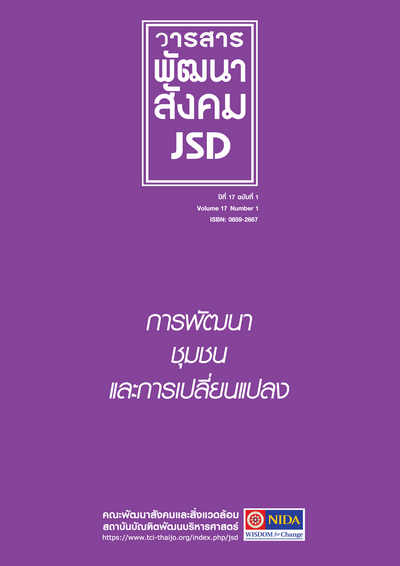ทำความเข้าใจเรื่องการพัฒนาผ่านข้อถกเถียงทางทฤษฎี
Main Article Content
Abstract
บทคัดย่อ
นับตั้งแต่สงครามโลกครั้งที่สองยุติลง สังคมต่างๆจำนวนมากซึ่งส่วนใหญ่อยู่ในแอฟริกา เอเชีย และลาตินอเมริกา ได้รับเอกราชกลายเป็นรัฐชาติหลังจากเคยตกเป็นอาณานิคมของตะวันตกมาเป็นเวลานาน รัฐยุคหลังอาณานิคม ซึ่งเรียกชื่อรวม ๆ กันว่าโลกที่สามเนื่องมาจากมีลักษณะ “สภาพล้าหลัง” ได้นำไปสู่การก่อตัวขององค์ความรู้ว่าด้วยการพัฒนาขึ้นมาในแวดวงวิชาการของตะวันตก ซึ่งเรียกว่าทฤษฎีการทำให้ทันสมัย ก่อนถึงปลายคริสต์ทศวรรษ 1960 ทฤษฎีนี้เป็นมุมมองกระแสหลักที่ครอบงำทิศทางการพัฒนาของโลกที่สาม หลังจากนั้นก็ได้ถูกวิพากษ์วิจารณ์อย่างหนักอันเนื่องจากผลในเชิงทำลายล้างของการพัฒนาในโลกที่สาม ทำให้มีการปรับแก้ทฤษฎีขนานใหญ่ การวิพากษ์วิจารณ์ที่โดดเด่นที่สุดก็คือทฤษฎีพึ่งพิงที่เรียกร้องให้ปฏิเสธทฤษฎีการทำให้ทันสมัย ต่อมาได้มีการปรับขยายทฤษฎีพึ่งพิง อันมีผลให้เกิดทฤษฎีระบบโลกขึ้นมา การปรากฏตัวของประเทศที่มีความก้าวหน้าทางเศรษฐกิจในระดับสูงในภูมิภาคเอเชียแปซิฟิก สามารถอธิบายได้ด้วยทฤษฎีระบบโลก ทฤษฎีการสร้างความทันสมัยและทฤษฎีระบบโลกต่างก็เป็นทฤษฎีที่ครอบงำความรู้ด้านการพัฒนา เนื่องจากทั้งสองทฤษฎีนี้มีความเหมือนกันบางอย่างทั้ง ๆ ที่ในความเป็นจริงนั้นมีความแตกต่างกันอย่างเห็นได้ชัด ทั้งสองทฤษฎีนี้ล้วนมาจากประสบการณ์ของยุโรปและได้ถูกสร้างขึ้นมาโดยปัญญาชนที่ได้รับการอัดฉีดความคิดทางการเมืองของยุโรป ด้วยเหตุนี้ ทั้งสองทฤษฎีนี้จึงมองจารีตประเพณีและวัฒนธรรมที่ไม่ใช่ตะวันตกว่าไม่มีความสามารถที่จะทำให้เกิดการพัฒนาแบบทุนนิยมได้ ขณะที่ทิศทางของวัฒนธรรมที่เอื้อต่อการพัฒนามีความสำคัญอย่างมากในสายตาของนักทฤษฎีความทันสมัย แต่อุดมการณ์ของการพัฒนากลับมีความสำคัญมากกว่าสำหรับนักทฤษฎีระบบโลกในฐานะเป็นตัวกำหนดผลลัพธ์ของการพัฒนา อย่างไรก็ดี ตั้งแต่คริสต์ทศวรรษ 1980 เป็นต้นมา ได้มีการบรรจบกันทางความคิดระหว่างทั้งสองทฤษฎีนี้โดยเฉพาะในส่วนที่เกี่ยวกับบทบาทของรัฐในการพัฒนา
ทั้งสองทฤษฎีนี้ได้ปรับเปลี่ยนมุมมองจากการให้ความสำคัญกับปัจจัยทางเศรษฐกิจในฐานะเป็นตัวกำหนดการพัฒนามาเป็นการให้ความสำคัญกับการเมืองในการพัฒนาระดับชาติ
คำสำคัญ: การพัฒนา ทฤษฎีการทำให้ทันสมัยอย่างตะวันตก ทฤษฎีพึ่งพิง ทฤษฎีระบบโลก รัฐเข้มแข็ง
Abstract
Following the end of World War II, a large number of societies, mainly in Africa, Asia and Latin America, gained national independence from Western colonialist countries. The emergence of post-colonial states, known as the Third World because of their “backwardness”, led to the formation in the West of the first theory of development called the “modernisation theory (MT)”. Until the end of the 1960s, MT had been a dominant perspective on the development of the Third World. After that the MT was severely criticized because of the destructive impact of the development in the Third World. As a result, MT was being reformulated. The most remarkable criticism came from supporters of the “dependency theory (DT)”, who called for rejection of MT. Later, DT was revised and became the “world system theory (WST)”. The emergence of the HPAEs (high-performing Asian economies) in the Asia Pacific region can be accounted for by WST. Both MT and WST are dominant theories of development. The two theories share some similarities despite their considerable differences. Both schools of thought were derived from European experience and were formulated by intellectuals dominated by the European political ideology. Accordingly, both consider more or less explicitly non-Western traditions and culture as incapable of generating capitalist development. In determining development outcomes, while cultural orientation to development is of crucial importance to modernisation theorists, the ideology of development is far more important to world system theorists. Since the 1980s, however, there has been a convergence between the two theories on the role of the state in development. Both theories have to shed their original economic determinism to address the primacy of politics in national development.
Keywords: Development, Modernisation Theory, Dependency Theory, Worlds System Theory, Strong State


